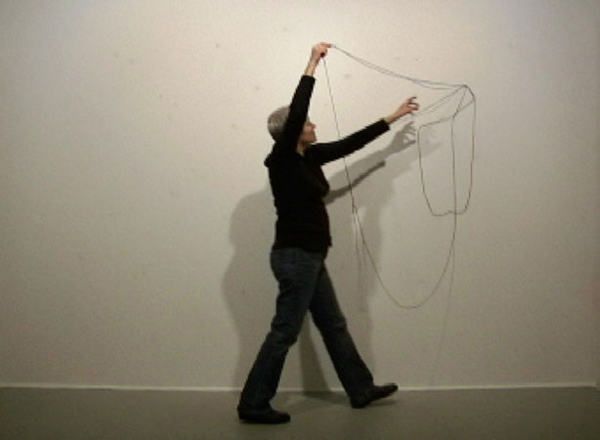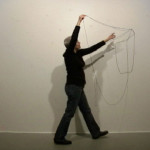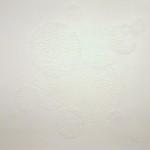By DAVID O. AVRUCH
Likely owing to my ADD pedigree, exhibitions comprised of nothing but drawings tend to be underwhelming experiences. Inked nudes on textured paper, oversize charcoal portraits, sketches of furniture... Why? Good art can come in any medium, obviously, but drawing may be the toughest one to get excited about. I approached the Mills Gallery's biannual Drawing Show, Drawing the Line, braced for a well-curated snooze. I shouldn't have stressed: there was only one charcoal portrait in the set, and it stuck out like hell. In fact, it didn't take long for the wall-spanning installation of wire and blood-red thread, the three-screen video slot machine, and the trio of X-acto-lacerated newspapers to collectively pose the obvious question: what did this show have to do with (um) drawing?
Answer: everything (duh). According to a statement by the guest juror, artist Maria Magdalena Campos-Pons, "Provocative examples of drawing are to be found in architecture and design, performance arts and new media, as well as in seductive rendering made by using more traditional approaches." If the quality of the exhibition wasn’t what it was, the profession of artist would qualify as contradictory and evasive; however, the principal strength of Drawing the Line did indeed lie in its diversity of medium, scope and message. The 27 pieces were, by turns, whimsical and existential and violent and charming. There were some standouts and a couple duds, but overall the show was a seamlessly organized, aesthetically solid and intellectually profitable. It is eclectic yet accessible, serious and fun.
But come on: mixed media? Video art? Just where does this juror get off?
The art itself held some answers. Campos-Pons, who chose the works from more than 400 entries, knows a good thing when she sees it: Untitled by Rosana Castrillo Diaz (an invited artist who skipped the jury process) is our proof. This wall-mounted installation, about four feet by four feet, is composed of hundreds of Oreo-sized rings of transparent tape, sticky-side out, each less than a quarter-inch in width and varying slightly in diameter. The rings coalesce to form 11 discs of different sizes that intermesh like Venn diagrams, while two spore babies float independently. Its intense modularity evokes cellular tissue: if god had a tumor, Untitled is what the biopsy would look like under a microscope. The plastic needles that anchor the piece to the wall vary in length so that some areas hug the plaster while other regions float an inch away. This puts the gallery's lights and walls to work as the complex webbing of shadows engages the viewer's perception of depth. The piece is in fluent conversation with its environment.
Untitled is a siren; almost never have I wanted to touch a piece of art so badly. What's remarkable is that its process of facture is so accessible that questions of meaning simply fade away. There is no statement here, just the material - tape - and its simple, sublime transcendence from mundane implement of craft to effective art object. To extrapolate this in terms of the show as a whole, the viewer could be understood as being asked to discard his/er preconceptions about what a drawing is or means. By doing so, she acknowledges the potential for transcendence and allows the sublime an opportunity to do its thing. In other words, tough love, maybe along the lines of, "Shut up, you might learn something." Yes'm.
If Untitled hadn't de-qualmed me, then Nancy Murphy Spicer's Hanging Drawings 1 (20 Successive Drawings, Unique and Unrehearsed) would have. Spicer stuck 50 pins into the wall in no particular order and draped a long loop made of black friction tape through them. A handwritten note on the wall encourages the viewer to rearrange the cord to make a new drawing; a video monitor displays the artist's 20 demonstrations.
Like Untitled, Hanging Drawings succeeds through its simple, overt engagement with its materials and environment. Not only is it interactive and fun to use (draw?), it is a fully realized work of art. Engaging in a three-way conversation between the viewer, the pins, and gravity, the black friction tape becomes an extension not only of the viewer's artistic will but of his/er understanding of the work's specific parameters and his/er flexibility in interpreting them. In this way, the piece is almost self-aware. It is a delightful piece.
As I said, not all were winners. For example, A. Jacob Galle’s six-minute black-and-white silent video, 4.11.04 Ice Cutting, portrays a man on a semi-frozen lake hacking a shelf of ice free from the shore with a hatchet, then uses time-lapse images to show the ice floating back and forth. This piece, which manifests all the subtlety of an egg salad sandwich, elicited a resounding "So what?" Likewise, David Ortega's Apocalypse (Quaint/Cuddly Remix), a grouping of neon vinyl stickers on the gallery's front window representing acid rain and explosions, was not quite comprehensible without its title. Though playful and unserious, the work remained unexceptional on its own terms.
In general, the show was stimulating and worthwhile, as the Mills Gallery usually is. Aesthetics from indie to hip-hop to sci-fi to Deconstruction, with tons of abstraction, completed the buffet. Although there wasn’t a lot to see in the way of traditional drawing, that's fine. In fact, if Drawing the Line is any indication of what drawing means today or where it's going, then please, Ms. Campos-Pons, take me with you.
- Nancy Murphy Spicer, Hanging Drawings 1 (20 Successive Drawings, Unique and Unrehearsed), Video Demonstration, 2007. Image Courtesy of Spicer.
- Rosana Castrillo Diaz, Untitled, Transparent Tape, 2007. Image Courtesy of Diaz and Anthony Meier Fine Arts
"Drawing the Line" is on view through 6 January 2008 at the Mills Gallery of the Boston Center for the Arts.






